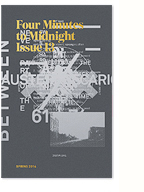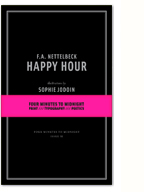I’m so excited to come across James Stuart’s Master’s Thesis “It Begins in the Book: Writing the Material Poem” freely available online. An expansive thesis, it comprises an 80-odd page exegesis and 3 creative projects (The Material Poem, The Homeless Gods and Conversions). The overlap between his interests and my own is startling, given the niche nature of my concerns.
My reading of Stuart’s written thesis has sparked many ideas for my own research, specifically around his three-pronged model of materiality:
“what enables, and how does, a reader to respond to a literary work (material basis); what socio-cultural forces influence the relationship between writers, readers and the language-object (materialism); and finally, the actual material expression (or materiality) of a language-object.”
Coming from his background as a poet, Stuart’s examples and references are new and fascinating to me, and his analytic focus on poetry (specifically in its definition re: its material basis) has given me a lot to chew on.
Mallarmé is the starting point, as he was for my own investigation into experimental typography (as touched upon in my MA Thesis), and it’s interesting to see the different path Stuart charts from there as compared to my own. His definitions create a strong backbone for his thesis, but critically, the emphasis on differentiation between prosaic language and poetic language, and the following and repeated justifications for the necessary material consideration of poetic texts, seem a bit stunted and obvious, especially to any designer who lived through the so-called “legibility wars” of the 90s.
The lack of attention paid to design discourse of this period, as charted through the pages of Emigre (let’s not forget, which started as a poetry zine), seems to me to be a glaring omission. Furthermore, the forays into new media texts (in Chapter 3) also feels quite dated, given the currency of hypermedia explorations back in the day of the DVD-ROM. The evaluative structure Stuart proposes for his projects, almost as a conclusion, feels quite limiting, given the breadth of his thesis, and again could have benefitted from an understanding of the decision-making process/analysis of design practice.
There’s no doubt that Stuart’s thesis deals with his subject matter with far more rigor than most design writing (including my own), but I can’t help but feel that there’s still quite a bit missing, and a lack of real attention paid to the actual material expression that he alludes to. How does ink and paper, metal and wood, and fine, the screen, mean? And what of the socio-cultural, political currents that affect the modes of production (materialism from a Marxist perspective) and consumption of poetry?
If I’m levelling these criticisms, it is not to discredit Stuart’s thesis, which is generous and engaging in dealing with a subject I hold dear, but it emerges out of a frustration with the valorisation of design discourse (at least, design discourse of a certain period) within related disciplines. Stuart does conclude with a theoretical architectural model (based on Arakawa and Gins work), but misses the contributions of graphic design thinkers dealing with arguably far more similar subject matter. The development of graphic design theory liberally borrowed from literary criticism, it is a shame that it isn’t a two-way road. The gap needs to be bridged.
Reading “It begins in the book” has inspired and frustrated me, inciting me to revisit those old Emigre essays (and the important Visible Language series), with Rudy Vanderlans, Anne Burdick, Andrew Blauvelt, Van Toorn, et al. It has also encouraged me to continue to dig deeper in developing my own research, and hopefully eventually contribute to a sadly lacking contemporary discourse. Finally, and this IS something, it has confirmed my continued interest in poetry, but also my rejection of it as a from of working, I’ll stick to the term ‘poetics’.
Keep walking, this isn’t poetry anymore…
2 Comments so far
Leave a comment
First, thank you for the very engagement with the topic. I think, at heart, we agree on the lack of true interdisciplinary discourse between literature and those media which express it as a material object (graphic design in this case). It’s also clear that attempts to form such a theoretical vocabulary will be biased by the background of the academic/student/amateur in question.
As such, I could note that what has frustrated me with the design field’s engagement with poetics is that it has often been limited to cover design, some witty typographical treatments and, occasionally, but not so much the way in which literature and poetry specifically make meaning. This was an attempt (and certainly not a complete one).
Most of the reading I conducted around graphic design and visual language revolved around history and semiotics, rather than the theories you mention. Given the opportunity to delve into the subject again, I would gladly revisit this. I only wish I had taken advantage of the interdisciplinary opportunities available at my uni (UTS) which has a well-respected school of design.
The world of digital poetics is by and large limited by the works produced in the genre. And I’m happy to acknowledge that things have certainly moved on since I wrote this in 2009.
The only real point I would take issue with is your comment that my insistence on the difference between poetic and prosaic language being ‘stunted and obvious’. It’s a throwaway line that belies the real question: why are the two so different yet treated the same materially? Without that study as a fundamental basis upon which to engage with the materiality of the poetic object, we will be walking on thin ice, especially when you walk into a room full of humanities academics (again, the background bias shows up).
That said, design discourse is an obvious choice for the next chapter of my thesis (whenever that moment comes)…
Comment by James 12.22.12 @ 9:00 pmHi James,
Thanks for your comments, and my apologies if my criticism came off a little harsh. As I mentioned, it was due to my own impetuous frustration, rather than anything inherent to your thesis.
To be honest, with a bit of hindsight and further research, I’ve realised that the lack of interdisciplinarity is in large part due to a dearth of contemporary design writing as much as anything else. However, for a while there was definitely some good writing exploring graphic design as language, as a form of meaning-making, beyond cover treatments, etc. A particularly pertinent essay would be Steve Baker’s A Poetics of Graphic Design? (note the question mark!), and also Gunnar Swanson’s collection Graphic Design & Reading. Nonetheless, without a doubt, the discourse is sadly lacking…
As for digital poetics, there’s a wide variety of work that you might be interested in. I’m particularly fond of Jhave’s work, and have a soft spot for Young-Hae Chang‘s work, as simple as it is.
As for your insistence on the difference between poetic and prosaic language, again with hindsight, I realise my criticism is pretty unfounded (and badly worded, my apologies again), and you are right to argue for its importance. I suppose from my perspective, I was jumping the gun a bit, having taken the difference for granted and wanting to focus my attention on exploring their material differences and manifestations.
I suppose it’s a broad field (for something so niche, heh), with too many closed worlds, poetry, “vispo”, experimental literature, intermedia poetry, not to mention the use of language by conceptual artists, etc. Graphic design did jump into this exploration briefly and has since backed out. I’d like to hope that something could be gleaned from this foray into theory, and hopefully built upon in the near future.
Comment by Kevin 12.31.12 @ 2:01 pmLeave a comment














